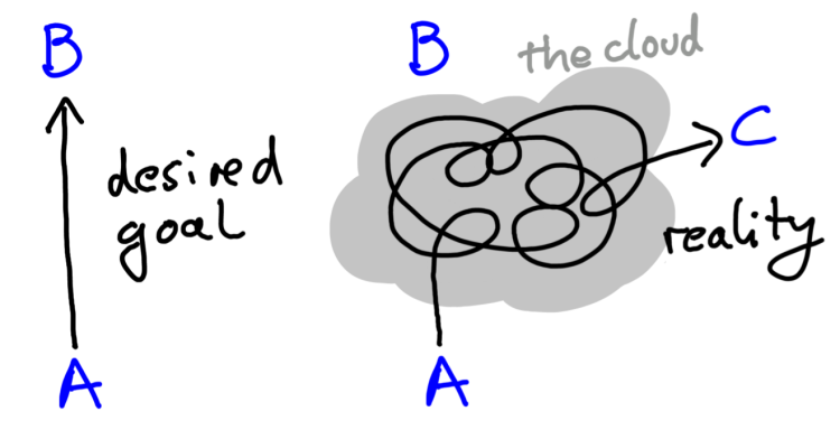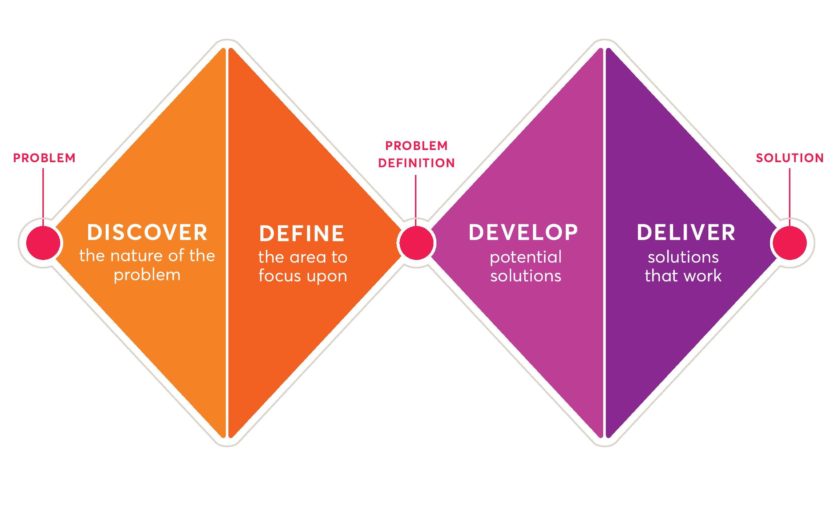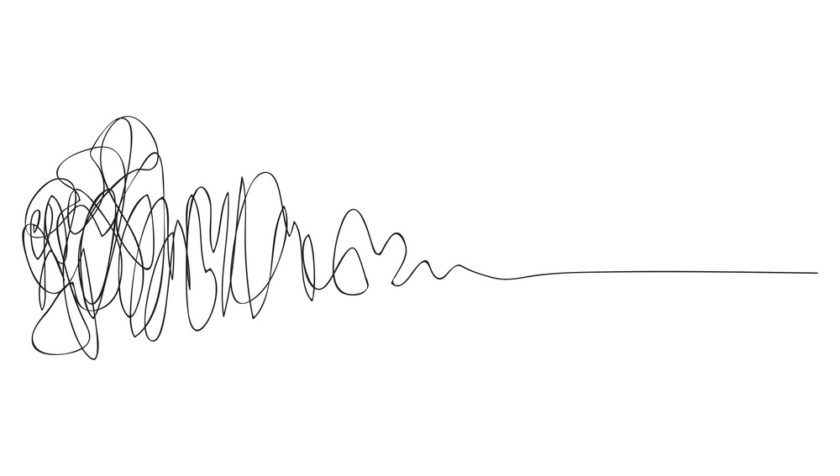Some of you are interested in what we get up to on our learning programmes. Here’s a run-through from the Australian and New Zealand cohort who just completed the third stage, the developing & testing week. Teams made sense of their interview data, and based on the insights gathered develop areas to test prototypes of potential solutions.
If we go back to our mountaineering metaphor; if induction & scoping is about preparing your kit, and exploring & framing is about charting your route and starting the climb, then developing & testing is about finding your anchor points up the mountain; uncovering insights and opportunities to ground futures ideas and action.
Entering into the cloud
A video we showed the teams back in the induction & scoping week became particularly relevant this week - Uri Alon ‘why science demands a leap into the unknown’. Uri shares his experience of scientific research, where you set out to go from A to B in a neat process, and as you go you realise that actually you’re going from A to C and going A to C means going into a ‘cloud’ of the unknown, struggling through it and then (hopefully), pushing through the edge of the known and emerging at C.
It’s a great video, (not to mention he brings in the value of improvisation which I think more people should do).
For the teams, this week was about entering into, and importantly staying in the cloud so they don’t default to the ‘known’ path of ‘B’ and instead push themselves further into the space of the unobvious, into unknown possibilities.
Living the design squiggle in three stages
Making sense - feeling your way through ‘the cloud’ to surface patterns and develop insights and opportunities.
Generating options - going beyond the room of the obvious and developing your response? What can and must be done?
Testing assumptions - finding a good fit through prototypes, pilots and experiments.
If we were to map that onto the double diamond, we’re moving across the ‘define’ to ‘develop’ stage. While that looks nice and neat written as three stages, there is, of course, nothing straight-forward and simple about this process.
The infamous design squiggle better represents this process and also represents how we delivered the training last week. On Wednesday we looped back from generating options (develop) back to the making sense stage (define). We felt the ‘how might we’ statements weren’t strong enough yet to continue into the developing potential solutions stage, hence the loopback.
This was confusing for the teams, but actually, a great teachable moment to show that while there are innovation processes to follow, this way of working is inherently messy and as teams working in-practice, without the structure of facilitators they need to be able to navigate their way through the mess.
Make it tangible enough to test
At this stage in the innovation process, opportunities need to become real, so that other people (the community, users, stakeholders) can better understand, interact with, engage with and provide feedback on possible solutions.
‘Making it real’ is about getting the opportunity out of the abstract space into a tangible, touchable, interactive ‘thing’ so that teams can realise in more detail what their intervention might be. And importantly having a ‘thing’ means you can learn what works and what doesn’t from others, to then iterate along the way.
Prototyping is always a fun and energising component of this process and what the teams built in the space of a few hours was no exception. We even had some alumni from the Victoria pilot programme join us that afternoon and interact with and provide feedback on the teams’ prototypes.
Mythbusters
As energising and fun as idea generation and prototyping are, Ryan (our core facilitator on this program) was keen to ensure that we don’t get swept up in the ‘myths of ideas’. There is no silver bullet, there is no idea that comes out of the blue to solve all the challenges. The ideation process is an important one, but we can’t forget that the hard work comes in gathering and understanding insights, it comes in practice and in the implementation and iteration of possible solutions.
Modelling
We spoke a lot about different types of models for making sense of projects - journey maps, system maps, personas, 3D modelling. But actually in this section, I want to talk about a different type of modelling - and no, not the catwalk type either - how do we model the change we want to see by demonstrating this change in the behaviours of how we work.
If this program is about ultimately changing the culture of government to a more experimental one. Then it’s important to reflect on the ‘how’ we’re working, and what principles we are using, and can use, to guide the processes we use to get project outcomes.
How we work, is how we think change happens.
For many of the teams’ challenges, the project themselves will not have outcomes over the course of this program. What they as a team can realise and influence is adopting and modeling new behaviours that demonstrate the change they are working towards.
If a tree falls in the woods…
We talk a lot about teams making their process visible and working out loud. To legitimise and spread new ways of working people need to know it’s happening.
So a shout out to the QLD team who were down in Melbourne for training at the same time as a whole of department showcase opportunity, instead of giving it miss the team filmed a one-take video of their project space, their learning so far and the questions they’re still asking of their challenge space. Showing how quick and easy it can be to share your ‘working out loud’ story.
Up next
This week we have a big thank you to Penny Hagen who joined us as guest faculty from the Auckland Co-Design Lab. She brought her immensely rich practical experience and a deep inquisitiveness for how we can challenge decision making power and how we might truly work with communities.
And we’ll be back again in July, for the final intensive face-to-face delivery on validating & embedding. Working with teams to understand how to legitimise their potential solutions and opportunities to embed their new ways of working further into government practice. We’re excited to be joined by Andrea Siodmok from the Policy Lab, Cabinet Office, UK for this session.








